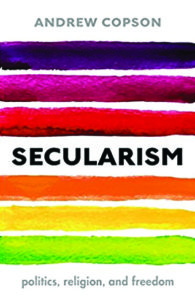Secularism: Politics, Religion, and Freedom

BY ANDREW COPSON
OXFORD UNIVERSITY PRESS, 2017
176 PP.; $18.95
In the not so distant past, say the 1960s or ’70s, a secular society seemed to be the obvious goal of all but the most backwards nations of the world, and certainly was the stated ideal in the United States of America. But in today’s world, where even mainstream American politicians want to see Christianity put into our Constitution, is that still the case?
In Secularism: Politics, Religion, and Freedom, Andrew Copson, the chief executive of Humanists UK, gives us a short, useful introduction to the idea of secularism, its history, and, most importantly, its present state in the world. And that state isn’t necessarily something to feel optimistic about.
Copson begins with a working definition of secularism—the ordering of society based on: 1) the separation of religious institutions from state institutions; 2) freedom of thought, conscience, and religion; and 3) equal treatment on the grounds of religion or a nonreligious worldview.
The first third of the book is a whirlwind history of secularism, starting in ancient Greece but quickly progressing to the Enlightenment in the 1700s and forward to today. Copson’s worldview is enlightening, and while he does discuss the Declaration of Independence and the US Constitution, he spends more time with the history of France and its secular, aggressive anti-clerical path in the nineteenth and twentieth centuries.
He then gives a chapter each to the broader arguments for secularism and against secularism. The strongest of the anti-secular arguments is the loss of a sense of national identity and social order. Further, the argument goes, secularism is laden with value judgments for the simple reason that secularization is nothing more than a way to push Western values onto non-Western cultures.
These chapters emphasize that secularism doesn’t equal atheism, although truly secular states are tolerant of atheists as well. But for most of its history, secularism is adopted to mediate between different religions, rather than between religion and no religion. Copson is also quick to point out that the communist countries of the late twentieth century were not at all secular, as they in fact mixed religion and government by setting up atheism as the official “state religion.”
While not giving in to anti-secular argument, Copson’s analysis sets the foundation for the book’s final chapter, entitled “Hard Questions and New Conflicts.” As the world faces increased migration, he observes, “Migration has been a spur to secularism, especially in its aspect as equal treatment of people with different beliefs. But, ironically, secular states have found themselves uniquely challenged by the growing diversity of their societies.” This cultural diversity no longer dissipates with time as it did in the pre-global communication era, when moving to a new place meant eventual adoption of most of the local culture. Now, even after moving, many communities can stay connected with their previous culture in ways they couldn’t before the internet, and in so doing create more discord among nativists.
While this may make secularism more difficult, Copson advocates that it is precisely these conflicts of culture that make secularism even more necessary than before. In the final chapter he notes that not only has secularism diminished, but even lip service to secular values has been abandoned in many states, particularly in the Arab and Islamic world.
In his brief afterword, Copson makes the pitch for holding onto secularism in this diverse world as “a framework for our common life” and notes that “most of us want that framework to be a fair one.” It may be imperfect, but (as with democracy) it’s certainly better than the alternative. Copson’s writing is clear and concise. His short book is almost all the more effective for its brevity, since it gives us a clear outline of secularism, what it’s done for the world, and what it could do in the future. If only the world gives it the chance.
